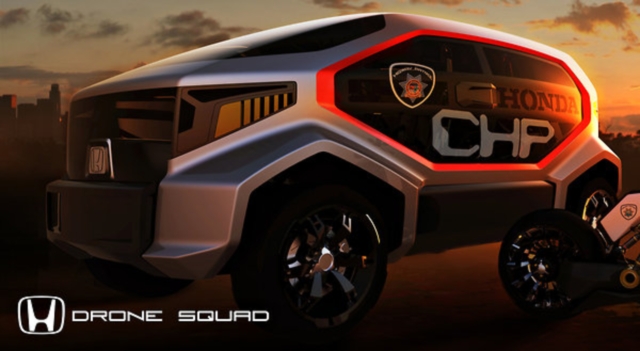 Highway patrol vehicles of the future will be mostly self-driving, if you accept the solutions offered by the entries in this year’s Design Challenge, an annual competition organized in conjunction with the Los Angeles auto show.
Highway patrol vehicles of the future will be mostly self-driving, if you accept the solutions offered by the entries in this year’s Design Challenge, an annual competition organized in conjunction with the Los Angeles auto show.
For the last nine years, the Design Challenge has invited automakers’ advanced design studios to dream up proposals for sci-fi automotive futures tied to specific themes, including cars that weighed less than 1,000 pounds or that were destined for Hollywood roles. This year’s competition asked designers to envision the highway patrol car of 2025.
By coincidence or destiny, designers at several companies came up with concepts for robotic, autonomously driven vehicles on ground, water and air. These future police cruisers — usually presented as story boards rather than actual vehicles — recall today’s Predator and Global Hawk drones, stars of the anti-insurgency efforts. They may give new meaning to those signs that read “Speed limit enforced by aircraft.”
In the future, as the organizers outlined it, “the vehicle should empower highway patrol officers to meet new demands and effectively both ‘protect and serve’ the public while considering not just enforcement needs but emission concerns, population growth and transportation infrastructure.” The world of 2025, the participants seem to agree, will be a place where traffic has grown exponentially, infrastructure has deteriorated, environmental constraints have increased — and highway patrol budgets have been reduced.
As envisioned by Honda R&D Americas’ advanced design studio in Pasadena, Calif., the future Honda CHP Drone Squad includes four-wheel Auto-Drones, like cars, and two-wheel Moto-Drones, like motorcycles. The proposal offers a future where the Auto-Drone functions as something of a command vehicle — manned or unmanned — that deploys Moto-Drones, even while on the move. The Moto-Drones could be rigged for a variety of different response or rescue tasks. While such vehicles might be decades from reality, the flexibility of this strategy could offer companies that built both types of vehicles an advantage in securing government contracts.
At the BMW DesignworksUSA studio in Newbury Park, Calif., designers dreamed up the E-Patrol (Human-Drone Pursuit Vehicle). In this arrangement, the officer and drone would work in harmony, like today’s officers and their K-9 partners. The BMW drone team would be able to deploy a flying drone, which resembles a high-tech Jet Ski cruise missile, or one of a pair of unicyclelike robotic vehicles to chase lawbreakers. And if the suspect doesn’t pull over? In the E-Patrol vision, the BMW designers say, their drone would disable the vehicle with an electromagnetic impulse.
The Subaru Highway Automated Response Concept vehicles, developed by Subaru Research and Development in Japan and designed specifically for Hawaii, are powered by renewable energy — and they have aquatic capability. “The cutting-edge SHARC patrol vehicles will provide an innovative, affordable and environmentally conscious solution for 24-hour highway monitoring,” the designers say.
The Volt Squad, dreamed up at General Motors’ Advanced Design Center in North Hollywood, Calif., is a set of future patrol vehicles that would take advantage of the propulsion system engineered for the Chevrolet Volt. The squad is composed of three different types of vehicles that still contain human officers. Each type is specially designed to observe, pursue or engage — the last term left menacingly undefined.
Judges for the Design Challenge include Tom Matano, director of the industrial design program at the Academy of Art University in San Francisco; Imre Molnar from the College for Creative Studies in Detroit; and Stewart Reed, chairman of the transportation design department at the Art Center College of Design in Pasadena. The winner will be announced on Thursday at an event in conjunction with the auto show.
Source: NY Times
